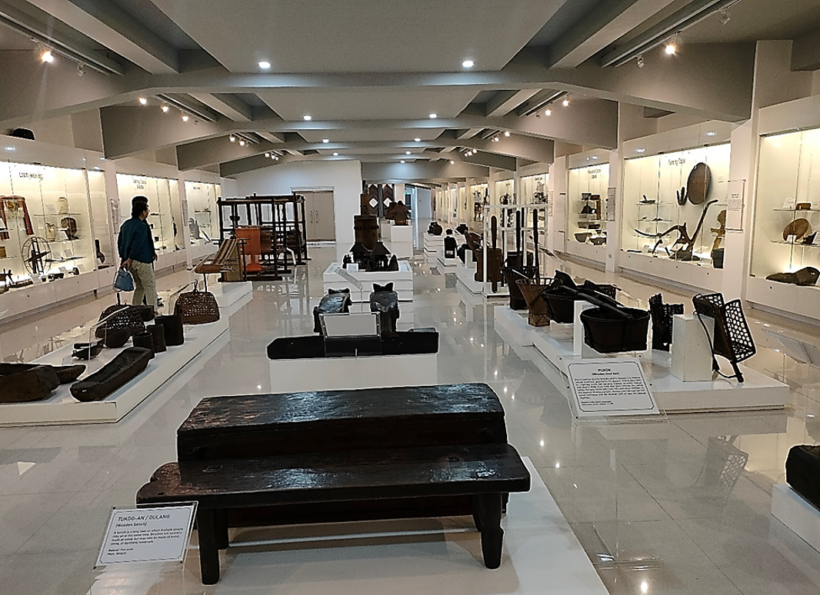Saint Louis University, Baguio City
by Genevieve B. Kupang and Gaston P. Kibiten
“All things must come to the soul from its roots, from where it is planted.” – Saint Teresa of Avila
Mulugod naming binabati ang lahat sa pagdiriwang ng makabuluhang Buwan ng Wika (Joyful greetings to everyone in celebrating a meaningful ‘National Language Month’)!
In celebration of the language month, this article will let you read terms uniquely used by the locals in the Cordillera Administrative Region (CAR), Northern Philippines, and see some items that are inside the Museum of Igorot Cultures and Arts (MICA), an ethnographic museum.

Dapilan (traditional sugar cane presser): The dapilan extracts juice from freshly cut sugarcane stalks. The stalks are fed in between the two wooden cylinders, which are made to rotate against each other through a lever moved around by men or nuwang (water buffalo). The rotating cylinders crush the sugarcane stalks and squeeze their juice, which flows down a channel and into a container. The juice is processed to produce basi (sugarcane fermented alcohol), tagapulot (brown sugar), or inakub (disc-shaped sugar caramel). It is noted that the ‘dapilan’ is found only in the warmer mid-to-lower elevations of the Cordilleras where sugarcane grows abundantly. Photo credit: Matthew Henri B. Kupang
This pandemic has afforded my youngest son and me the opportunity to visit one of my alma maters, Saint Louis University in Baguio City, particularly the Museum of Igorot Cultures and Arts, located in the university library building, the Msgr. Charles Vath Building. There I met a brother-anthropologist, Dr. Gaston “Buhay” Kibiten, the museum curator.
In an epitaph, we learned that the museum is dedicated in grateful remembrance of the pioneering CICM missionaries from Belgium and the Netherlands who served in the Cordillera region (then called Mountain Province) in the early 1900s.
You have come and gone
Like flowers springing up, brightening the land
wilting away as their season came to end
Lest collective memory fails,
let this humble space keep your names
and faces from fading away…

L: Rev. Fr. Seraphin ‘Seraf’ Devesse, CICM, the founder of Saint Louis School (SLS) in 1911; R: Rev. Fr. Florimund Carlu, CICM, the missionary who succeeded Fr. Devesse in 1913 and developed SLS.
The museum also pays homage to the Igorots’ ancestors who fiercely defended their independence and ways of life against Spanish colonial rule and influence. Their defiance – for which they paid so dearly – led to the conservation of much of the indigenous pre-Hispanic cultures in the region. The artifacts exhibited in the museum form part of this priceless heritage, which is offered to everyone to appreciate and enjoy.
CICM Collections and Archive
The Museum has a special room for artifacts and documents associated with the CICM missionaries.

‘Kul-log’ as Christian altar: The kul-log is a wooden storage bin traditionally used for the safe keeping of jars, rice, grains, and foodstuff. The CICM missionaries, with their appreciation for the local culture and their initiatives toward the inculturation of the Christian gospel, intentionally re-purposed this kul-log as an altar, together with a smaller one as a matching tabernacle. These were used in the chapel of Saint Louis University from the late 1990s to about 2010.
In this section is a collection of Catholic religious artifacts that were donated by the late Fr. Lode Wostyn, CICM, in loving memory of Antoon and Ines Wostyn-Spiessens of West Flanders, Belgium. Fr. Lode arrived as a missionary in the Philippines in 1969. He served as a professor at the San Carlos Seminary, Manila, Maryhill School of Theology (MST), Quezon City, Saint Louis University, Baguio City, and other schools. A prolific theologian, he has authored several books and articles in theology. He died in Torhout, Belgium in 2020. Well, Gaston and I had the privilege to be under Fr. Lode’s tutelage at MST.

Retablo of the Blessed Virgin Mary. This wooden carved retablo is one of the collections in this section.
The Term Igorot
For readers outside of the Cordillera, the term Igorot is explained by renowned anthropologist and historian William Henry Scott’s in “The Origin of the Word ‘Igorot’” (1971). It comes from the root word golot (related to Tagalog gulod), meaning “mountain chain,” and the prefix i, meaning “people of” or “dwellers in.” An indigenous Filipino word originally meaning “mountaineer,” it appeared in the earliest records of the conquest of Luzon. By 1700, it was applied by the early Spaniards to those living in the mountains of the present provinces of Nueva Vizcaya, Pangasinan, Ilocos Sur, Benguet, Mountain Province, Ifugao, and extended to Apayao in the 1770s and Kalinga in the 1880s. In the early 1990s, the term was used by American anthropologists for all peoples of the Cordilleras, including the Tingguians of Abra…”
Main Gallery Sections
The museum has several sections, each with its own description: 1) wood arts; 2) musical instruments; 3) clothing and textiles; 4) personal adornments; 5) bags and accessories; 6) spirituality and ritual; 7) house architecture; 8) household and kitchen utensils with subsections: food bins and storage food trays and dishes; cooking utensils; food processing equipment; rice-husking implements; 9) furniture and equipment, 10) farming implements, 11) rain and sun protectors, 12) hunting, fishing, and food gathering, 13) loom (weaving) implements, 14) blacksmithing, carpentry, and wood carving, 15) gold mining and processing, 16) animal raising paraphernalia; 17) betel nut, tobacco, alcoholic drinks, 18) weaponry, 19) funerary articles. 20) photographs/ paintings of Igorot folklife, 21) prehistoric stone tools, 22) collections from other Filipino ethnic groups, 23) CICM collections and archives, and 24) miscellaneous.

L: Menkalkalaleng ay am-ama (a man playing the nose flute): An artistic wood carving showcasing a man playing the nose flute, wearing various accouterments peculiar to the Igorots, and surrounded by familiar animals. R: Solibao and Gangsa (conical tenor drum and brass gongs of Northern, Philippines). Photo credits: Matthew Henri B. Kupang.
Wood Arts
The traditional Igorot woodcarvings were limited to human figurines like the bulol and the tinagtagu. There were also surface carvings of human, animal, and geometric forms on house posts, beams, doors, and walls, which were like the designs found in textiles. These were artistic works but had more ceremonial and symbolic functions. However, since the 1950s, woodcarving went beyond the traditional forms and their symbolic-ceremonial functions. All kinds of items were carved, either as decorations for utilitarian objects or purely for artistic expression and appreciation. [The collections presented are mainly contemporary artworks depicting aspects of traditional Igorot cultures and everyday life.]

Musical Instruments

Music was part of the everyday life of traditional Igorots. The main musical instrument shared across the various ethnic groups is the brass gong. Played together as a set (though in varying numbers), the gongs were used mainly during community festivities and big ceremonial occasions and were always accompanied by dancing.
In addition to gongs, there were other instruments that can be classified as wind, percussion, or string instruments. The wind instruments include the mouth and nose flutes, pan pipes, mouth harps, and horns. The percussion instruments are thrbalimbing, patatag, tambi, tungatong, tal-lak, and solibao. The string instruments are the ageldang/akelshang and the kulit-tong (bamboo zither).

Matthew Henri B. Kupang, the museum archivist Dr. Gaston P. Kibiten, and Dr. Genevieve Balance Kupang. “A fruitful tree never ceases to bear fruits even in the hardest of seasons,” a Ghanian-American friend Dr. Emmanuel Sogah once mentioned to us. This is true for MICA’s archivist and his staff Ariel who made use of the pandemic lockdowns to carefully assess, itemize, label, group by section, arrange, hang, and display ethnographic artifacts that tell the interesting stories within a story and serve as an educational hub for visitors and locals alike. Photo credit: Ariel Herrera.
More sections to discover
We hope to offer you more educational information in the next articles of the series. Come, appreciate, and learn from the ethnographic displays at the SLU Museum of Igorot Cultures and Arts.
About the Authors:

Gaston P. Kibiten serves as curator of the Museum of Igorot Cultures and Arts and coordinator of the Center for Indigenous Studies at Saint Louis University, Baguio City. He also chairs the Board of Trustees of the Igorot Global Organization Scholarship Program which aids promising but financially challenged college students from the Cordillera Administrative Region.

Genevieve Balance Kupang. President of Iyaman Interdisciplinary Research and Development, the vice-chair of Sandiwa, a lay associate of the Episcopal Commission on Interreligious Dialogue of the CBCP; the chair of the Special Interest Groups of the World Council for Curriculum and Instruction; and an incorporator of the Asian Social Institute.






